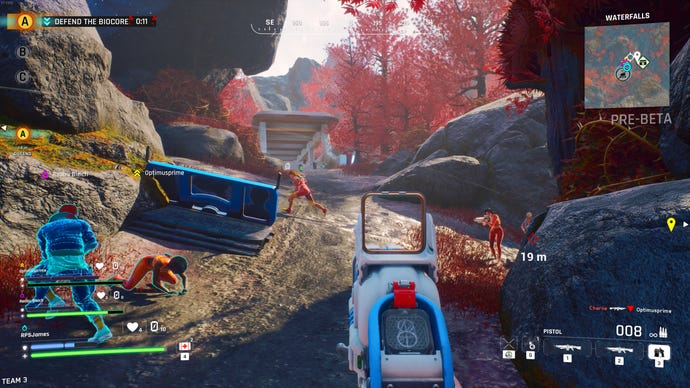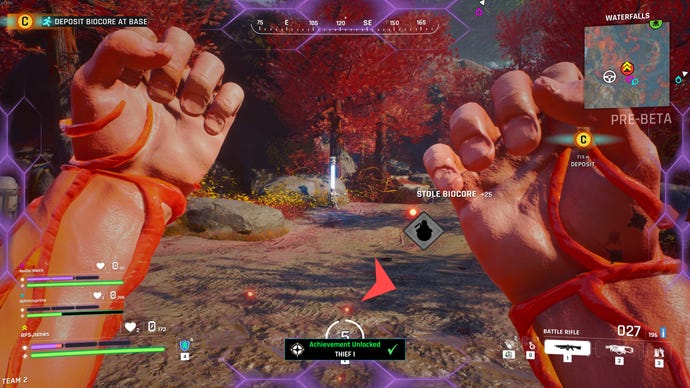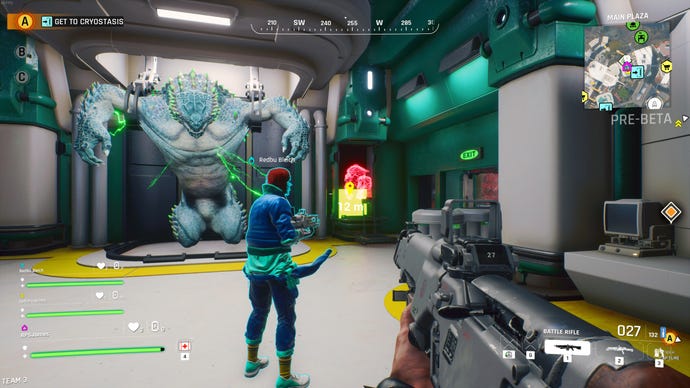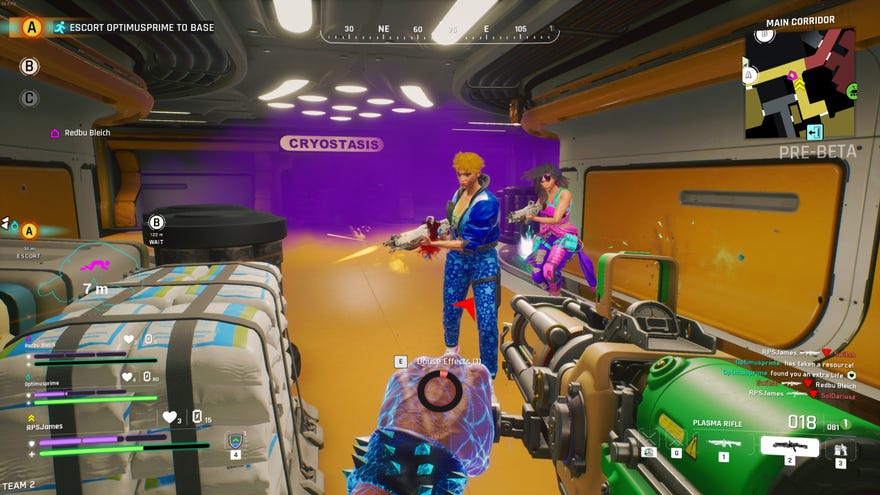Ascendant Infinity’s lunkhead tone belies an intelligent team shooter
PlayFusion’s loudmouthed FPS lets you make the calls
I promise that I mean this as an actual compliment, but having played an early build of Ascendant Infinity – Cambridge-based PlayFusion’s debut FPS – the impression I keep coming back to is that it’s a lot smarter than it looks.
Further clarification: by "it," I mainly mean its characters. By the time of Ascendant Infinity, Earth has spent a millennium sliding deeper and deeper into post-apocalyptic hellishness, the few survivors being those who’ve awoken from a cryogenic freezing programme that began in the late 1980s and overran by 800-odd years. In a judgement error on the scientists’ part, every one of these human lollies is a smug, belligerent oaf, all of whom promptly set about killing each other for resources (again) in less time than it takes them to fix their quiffs.
I hate these people, these neon berks who spew out sub-Duke Nukem quips three times a minute, often in what appears to be an actual Duke Nukem impersonation. Despite them, though, I do quite like the game they’re in. As often as Ascendant Infinity’s jokes fail to land, its objective-heavy, 3v3v3v3 squad shooting is both cleverly designed and conducive to a more cerebral, tactical kind of fight-think on the player’s part.

There’s a lot of moving parts in its sole mode, Battle for the Biocores, but here’s broadly how it works. Four teams are set loose on the forested outskirts of a big, circular map, and must cross a no-man’s-land into a mazelike central facility that houses three precious Biocore orbs. The team that secures the most – by lugging each Biocore back to base and completing a lengthy extraction process – wins.
The fundamentals are simple enough, but each retrieval mission is awash with choices to make and risks to manage, especially with the inclusion of an economy system that lets teams trade scavenged resources for better guns and shields. You could, say, make a beeline for the first available Biocore, increasing the chances of getting back home first and making an extraction defence on your terms. But you’d have to make that stand with whatever gear you started with, or could snatch en route, while all three other squads may sacrifice first refusal of a Biocore in favour of tooling up for a steal play. Later on, even if you’re lacking in successful Biocore heists, it can still be worth taking a minute to hoover up credits and head to the shop instead of back into the fray. In one match, this very approach helped my team recover from a dismal start, unleashing upgraded weaponry on enemies that had exhausted their supplies with constant battling.

It's not just all about the loot economy, either. You can also go off in search of 'events,' powerful variables that can end a losing streak or cement an already strong standing. These vary from deployable artillery bombardments and poison gas traps to, wonderfully, a giant, mind-controllable lizard that one player can brainjack and control directly. Again, securing these requires taking a detour from direct Biocore pursuits, but they can prove incredibly powerful. One lucky lizard-controller terrorised a game of mine for a good ten minutes, chasing our buggies and disrupting Biocore extractions, until a three-way gunfight finally brought it down. And the beast served as a thrilling focal point even before being released, as it was initially my team that began the brain transfer process, before blaring alarms pulled multiple enemy squads into a lengthy (and ultimately unsuccessful) defensive shootout.
Not only is all this enjoyable in the moment, but it does away withy one of the most shoulder-sagging moments in multiplayer shooterdom: the part where you’ve just died, respawned, and now have to trudge back into the fight. In Ascendant Infinity, booking it back towards an engagement is an option, but not always the best one, and never the only one. You can hit up the shop, or search for hidden vaults, or try your luck with an event, or just go for a different Biocore while everyone else is fixated on the first. To get on the podium, you will need to get stuck in at some point, but there’s an unusual amount of freedom in how you can plan for and take that fight.

Don’t expect the same strats to work every time, though. Ascendant Infinity goes hard on randomisation, mixing up base locations, Biocore spawns, active events, and even the layout of the central structure between each match. The overall geometry is consistent – the map isn’t procedurally generated in the typical sense – but an artillery command tower might be open in one game and blocked off in another, while certain flanking routes might be redirected via locked doors. PlayFusion reckons this will favour players who are quick to adapt to their rejigged surroundings, though encouragingly, there’s also plenty to reward those who put the thought into learning the map’s constituent building blocks. The main lab is a warren of passageways and Deus Ex-esque oversized vents, and even with the random element, knowing which routes lead where can confer a major advantage in close-quarters Biocore squabbles.
The freeform, choice-rich manner in which matches play out should be a solid foundation for Ascendant Infinity’s ongoing development, of which there’s still plenty to come. It’s not launching until sometime in summer 2024, and even then, only into early access (I’m told it’ll be a conventionally paid-for game, not free-to-play, with character customisation items based on earned unlocks and "inter-player trading" rather than microtransactions).

Since PlayFusion are unlikely to rewrite and rerecord every single line of dialogue, at the top of my wishlist is a more refined feel to the shooting. The guns themselves are lovingly made, with a characterful metallic clackiness and some excellent animation work, but right now they don’t really have the crisp handling and tangible slug impact that the armaments of Apex Legends or The Finals do. Time-to-kill is quite high even for an unshielded foe, so if we’re going to be shooting each other this much, a little more tactility could go a long way.
Even so, consider me intrigued by Ascendant Infinity, maybe even to the point where I could endure its relentless bruh-ing on a more frequent basis.


